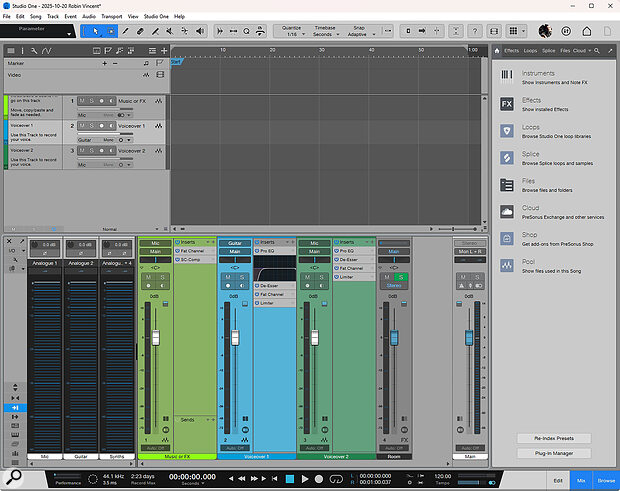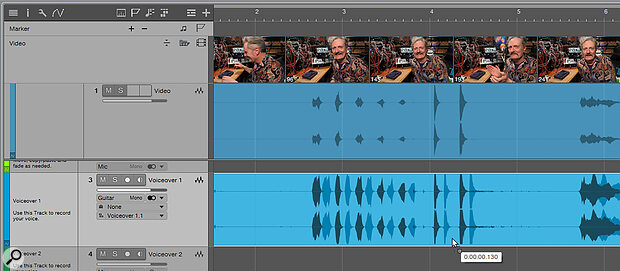 The Create Content template will load up a new session with everything you need to produce a two‑person podcast with music.
The Create Content template will load up a new session with everything you need to produce a two‑person podcast with music.
Studio One has everything you need to produce professional‑sounding podcasts.
Podcasts like to lean into the idea that they are recorded pretty much live, like radio, with minimal editing or post‑production fixing. That’s seldom the reality, though — and with a little bit of preparation, Studio One can reorient itself into a very efficient podcasting studio. In this workshop we’ll look into how to make best use of everything Studio One has to offer in the production of your next podcast.
Templates
 To kick us off, let’s load up the podcasting template, which presents us with a ready‑made recording environment. Click on New / Template and the Create Content option. This template loads up three tracks: one for music, and two for recording voices. The template also loads up the Marker track with a helpful ‘Start’ marker at the beginning, and opens the Video track (many podcasts are filmed at the same time for uploading to video‑based sites such as YouTube).
To kick us off, let’s load up the podcasting template, which presents us with a ready‑made recording environment. Click on New / Template and the Create Content option. This template loads up three tracks: one for music, and two for recording voices. The template also loads up the Marker track with a helpful ‘Start’ marker at the beginning, and opens the Video track (many podcasts are filmed at the same time for uploading to video‑based sites such as YouTube).
A couple of notes on video. You can’t record video into Studio One; you can drag video in afterwards, but you’ll need a way to align it with the voice tracks you recorded into Studio One. The simplest way to do this is with a clap. With the camera and audio recording, clap your hands a couple of times. That sharp explosion of audio will be recorded both through your vocal mic and the mic on the camera or phone.
Once imported into Studio One you’ll be able to easily see and align the claps on the recordings. Simply drag your video into the Video track and click the little waveform symbol. This will extract the audio from the video to a separate, but connected, audio track. You should be able to see how the waveform display in the video’s audio track matches up with your directly recorded audio. Finding the sharp peak of the clap will allow you to align your audio to the video more or less perfectly.
 If you want to video your podcast for release on platforms such as YouTube, you’ll need to make sure the video and audio are in sync. The easiest way to do this is to film and record a handclap and then, with the audio extracted from the Video track, line it up with your recorded audio in the timeline.
If you want to video your podcast for release on platforms such as YouTube, you’ll need to make sure the video and audio are in sync. The easiest way to do this is to film and record a handclap and then, with the audio extracted from the Video track, line it up with your recorded audio in the timeline.
Recording Setup
The first thing to do is to set up the recording space. We’re going to assume you’re using two microphones to record a podcast with two people chatting together. Ideally you’d want to treat this as a vocal recording in a recording studio, but that’s not realistic or necessarily comfortable for this format. You’re more likely to be in a living room, on a sofa or at a kitchen table. However, the same sort of rules apply as to how the space affects the recording. If there are lots of shiny or flat surfaces, you’ll get a lot of echo and reflections in the recording. If you can’t acoustically treat the entire space, at least cover surfaces with rugs or throws to deaden the sound a bit.
Positioning the microphones might take a little bit of experimentation, but for spoken word, as a general rule, you don’t want the mic too close. This is not a vocal performance; it should be a relaxed situation, with the mic placed where it’s not in the way of the conversation. If you are using capacitor microphones then start by placing them 12‑18 inches away and just to the side so that you can see your co‑host (this position should also helpfully avoid any plosives). Dynamic mics might need to be closer, but try not to threaten the...
You are reading one of the locked Subscribers-only articles from our latest 5 issues.
You've read 30% of this article for FREE, so to continue reading...
- ✅ Log in - if you have a Digital Subscription you bought from SoundOnSound.com
- ⬇️ Buy & Download this Single Article in PDF format £0.83 GBP$1.49 USD
For less than the price of a coffee, buy now and immediately download to your computer, tablet or mobile. - ⬇️ ⬇️ ⬇️ Buy & Download the FULL ISSUE PDF
Our 'full SOS magazine' for smartphone/tablet/computer. More info... - 📲 Buy a DIGITAL subscription (or 📖 📲 Print + Digital sub)
Instantly unlock ALL Premium web articles! We often release online-only content.
Visit our ShopStore.
